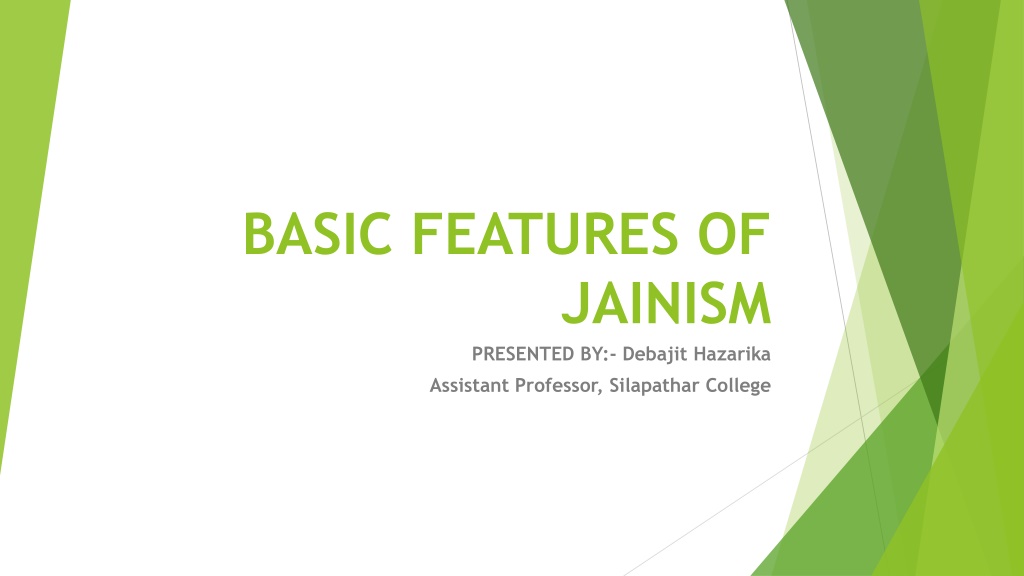Features of Jainism: An Overview Presented by Debajit Hazarika, Assistant Professor
Jainism is an ancient non-Vedic religion with roots tracing back to the times of the Indus Valley Civilization. It emphasizes non-violence, self-conquest, and spiritual liberation through 24 Tirthankaras, with Lord Mahavira being the most significant. Jainism stands out with its rejection of caste distinctions and Vedic traditions, focusing on karma, samsara, jnana, and mukti. This spiritual but atheistic religion views the world as eternal, offering a unique perspective on life and salvation.
Download Presentation

Please find below an Image/Link to download the presentation.
The content on the website is provided AS IS for your information and personal use only. It may not be sold, licensed, or shared on other websites without obtaining consent from the author. Download presentation by click this link. If you encounter any issues during the download, it is possible that the publisher has removed the file from their server.
E N D
Presentation Transcript
BASIC FEATURES OF JAINISM PRESENTED BY:- Debajit Hazarika Assistant Professor, Silapathar College
INTRODUCTION Jainism is a very old non-Vedic religion and some of its features go back to the times of Indus Valley Civilization. Like the Upanishads and Buddhism, Jainism was a kshatriya movement. It had its locus in a religion which was not yet touched by Brahmin cult. These regions East of sadanira (modern Gandaka) were inhabited by non-Aryan tribes. Jainism was formerly allied to Ajivikism. It is said to have been help by a number of 24 Tirthankaras and Lord Mahavira (B.C. 599-527) the last and the most important Tirthankara belonged to the clan of licchavis of Vaishali. This Vaishali was a janapada or oligarchy and was later on destroyed by Ajatashatru. Jainism is not an offshoot of Vedic Brahminism. It belonged to the people who were essentially agriculturist, who valued bulls and cows. They therefore had simple living and could practice ahimsa and austerities. In contrast, the Vedic Aryans were essentially pastoral people and they were used to animal-sacrifice. Naturally the Aryan and non-Aryan people of India were always in conflict, and, so in their religious beliefs too they held opposite views. In the long run, the Vedic Aryans accepted all that was of importance in Jainism and Buddhism. The present Hinduism is a commingled stream of Aryan and non-Aryan cults. Keeping in mind the independent and parallel development of Jainism, we can proceed further.
INTRODUCTION Jainism is essentially a religion of Tirthankaras. Jainism has come from the word jain which means the one who has conquered his passion. It essentially means the conquest of one s own self in bondage. Again, a Tirthankara is one who has built a ford which takes one across the ocean of bondage and suffering. A Tirthankara his not only conquered himself, but has taught people, the way out of this ocean of suffering. These 24 Tirthankaras have been mentioned, namely, 1. Rishabha, 2. Ajita, 3. Sambhava 4. Abhinandana, 5. Sumati, 6. Padmaprabha, 7. Syparshva 8. Chandraprabha, 9. Pushpadanta or Suvidhi, 10. Shitala, 11. Shreyamsa, 12. Vasupujya, 13. Vimala, 14. Ananta, 15. Dharma, 16. Shanti, 17. Kunthu, 18. Ara, 19. Mali, 20. Munisuvrata, 21. Nemi, 22. Nemi or Arishtanemi, 23. Parshanath, 24. Vardhamana or Mahavira. Rishabha muni has been identified whit the image of an ascetic God on a seal amulet of Indus Valley Civilization. However, this cannot be Rishabha Muni as this God is linked whit linga-worship. Excepting Parshanath and Lord Mahavira, other tirthankaras are more legendary figures than historical persons.
BASIC OR SPECIAL FEATURES OF JAINISM Jainism having its close association whit Ajivikism is the oldest non-Aryan religion of India. It is non-Vedic in the sense that it does not recognize the Veda as its religious scripture,--dose not admit caste distinction, and, is opposed to the Rgvedic religion. It accepts moksa and not heavenly abode as the highest human end. It also accepts non-Veda Yoga and austerities as important means for securing liberation. Unlike the Rgvedic principle, it accepts the four pillars of karma-samsara- jnana-mukti as its creed. It is wholly atheistic, but intensely spiritual from of religion. As there is no place for God in its system, so Jainism regards the world as eternal in its on-goings.
BASIC OR SPECIAL FEATURES OF JAINISM Though Buddhism too accepts ahimsa as an important moral creed, yet ahimsa is the central teaching of Jainism (ahimsa parmo dharmah) and, accounts for the moral conduct of jaina seekers and Sadhus. From the viewpoint of essence, Jainism is dualistic, for it admits the distinction between the two entities of Jiva and Ajiva. But from the viewpoint of number it accepts the plurality of spirits and of atoms. In order to give a system to its plural ontology it takes resort to anekantavada and syadvada. Jaina doctrine of soul is very distinctive, for it admits spatial dimension to it. Again, Jainism also admits that karmas are like subtle material objects that cling to the soul. This shows that Jainism has very primitive concept of soul.
BASIC OR SPECIAL FEATURES OF JAINISM Jainism, however, has a great deal of modern tone in the form of its rationalism. A Jaina thinker Ratna Shekhara in his book Sambadha sattari states that each man can realize his own self-sameness of the soul by own efforts without reference to any supernatural agency. Unlike Hinduism and very much like Buddhism, Jainism is associated with the historical figure (of Lord Mahavira), who might not have originated Jainism, but has given an authoritative seal to its principal tenets. Not only Jainism has no place for cast, it has no place for either Buddhist Scripture or the Rgveda as its religious scripture. It has its own religious book.























